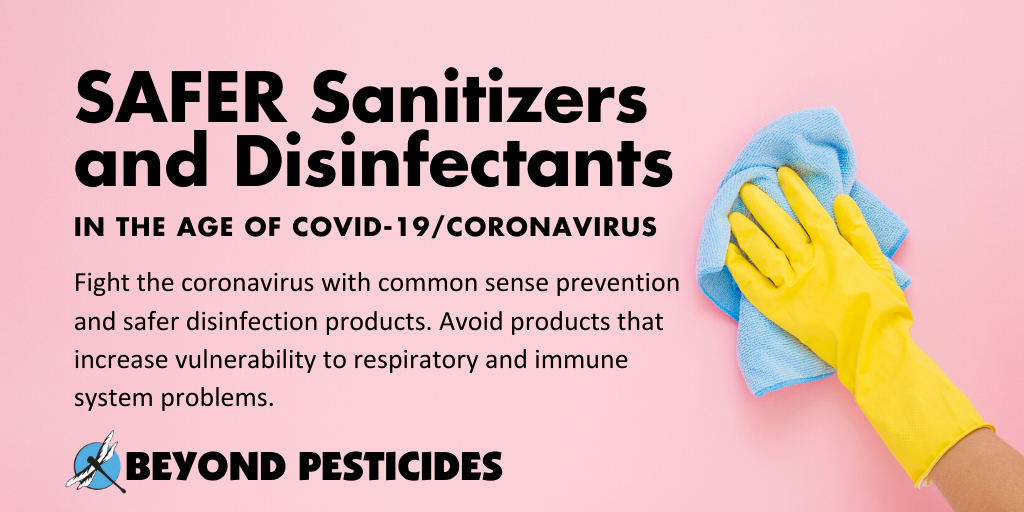20
May
World Health Organization (WHO) Warns Against Hazards of Toxic Disinfectants
 (Beyond Pesticides, May 20, 2020) The World Health Organization (WHO) released an updated advisory that warns, “spraying disinfectants can result in risks to the eyes, respiratory or skin irritation and the resulting health effects.” Beyond Pesticides recommends caution around toxic disinfectant and sanitizers and, to this end, offers resources and advice on products for use in the fight against Covid-19.
(Beyond Pesticides, May 20, 2020) The World Health Organization (WHO) released an updated advisory that warns, “spraying disinfectants can result in risks to the eyes, respiratory or skin irritation and the resulting health effects.” Beyond Pesticides recommends caution around toxic disinfectant and sanitizers and, to this end, offers resources and advice on products for use in the fight against Covid-19.
“Spraying or fogging of certain chemicals, such as formaldehyde, chlorine-based agents or quaternary ammonium compounds, is not recommended due to adverse health effects on workers in facilities where these methods have been utilized,” WHO reports.
While some governments are broadcasting chemicals or washing down sidewalks with disinfectants, WHO advises against the practice. “Spraying or fumigation of outdoor spaces, such as streets or marketplaces, is also not recommended to kill the COVID-19 virus or other pathogens because disinfectant is inactivated by dirt and debris and it is not feasible to manually clean and remove all organic matter from such spaces,” they state.
As individuals, companies, and governments respond to the novel coronavirus, it is critical that they respond with measures supported by scientific research and public safety. Using toxic cleaning products can be counterproductive to maintaining health during the pandemic—and there are safer products in the marketplace. In April, the New York Times described an increase in calls to poison control centers regarding illnesses resulting from use or misuse of toxic disinfectants during the pandemic. A month later, news agency KCRA described the same trend in California: the number of calls jumped from 262 in February to 796 in April.
“People are at home, they are worried about things being clean to kill viruses. People have been using more cleaning products than usual and maybe mixing them together. And just because people are using more of these products in the home, kids have access to them and are getting exposed that way,” said Justin Lewis, PharmD, DABAT, director of the California Poison Control System’s Sacramento office.
Toxic products are not necessary to keep families safe. For surfaces, the WHO guidance recommends using water and soap (or natural detergent) to remove organic matter and debris that can get between a surface and the disinfectant, then following along afterward with a product that breaks down microorganisms, including coronaviruses. Disinfectants that use natural-based substances are safer and can still eliminate the virus on surfaces. Examples of safer active ingredients include citric acid, ethanol, and isopropanol.
Individuals can protect themselves from Covid-19 by preventing exposure through staying home when possible, universal masking in public, social distancing, and washing hands. As Beyond Pesticides writes in its factsheet, Protecting Yourself from COVID-19 (coronavirus) without Toxic Sanitizers and Disinfectants, “Soap breaks down the virus’s fat membrane—and the infectious material falls apart—as long as you rub the soap on your hands for at least 20 seconds. Alcohol sanitizers with 60% ethanol or 70% isopropanol do the same thing. These chemicals break down the virus by a similar process, by breaking down the lipid covering of the virus.”
All unattributed positions and opinions in this piece are those of Beyond Pesticides.
Sources: World Health Organization, CNN, KCRA










